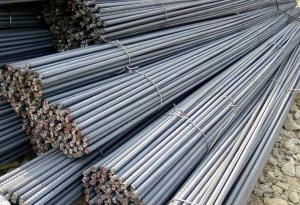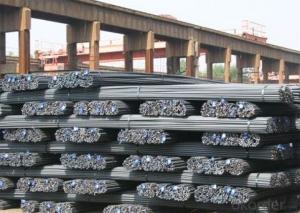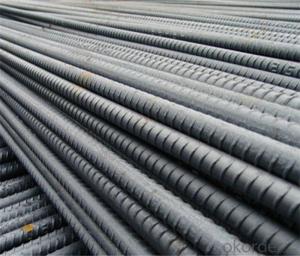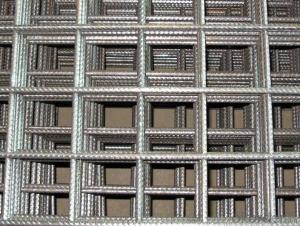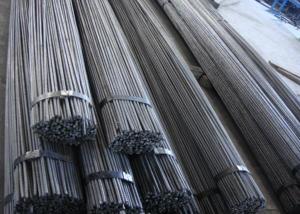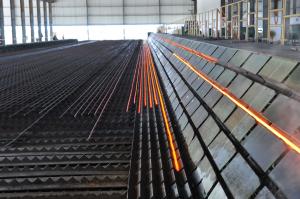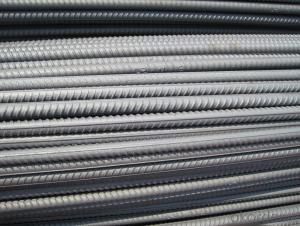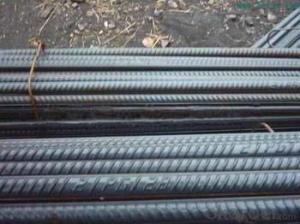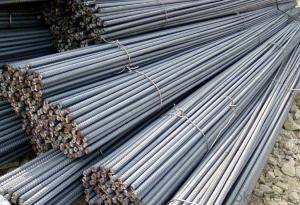Deformed Bar
- Loading Port:
- China Main Port
- Payment Terms:
- TT OR LC
- Min Order Qty:
- -
- Supply Capability:
- -
OKorder Service Pledge
OKorder Financial Service
You Might Also Like
Product Description:
Specifications of HRB400 Deformed Steel Bar:
Standard | GB | HRB400 | |
Diameter | 6mm,8mm,10mm,12mm,14mm,16mm,18mm,20mm, 22mm,25mm,28mm,32mm,36mm,40mm,50mm | | |
| | |||
Length | 6M, 9M,12M or as required | | |
Place of origin | Hebei, China mainland | | |
Advantages | exact size, regular package, chemical and mechanical properties are stable. | | |
Type | Hot rolled deformed steel bar | | |
Brand name | DRAGON | | |
Chemical Composition: (Please kindly find our chemistry of our material based on HRB500 as below for your information)
Grade | Technical data of the original chemical composition (%) | ||||||
C | Mn | Si | S | P | V | ||
HRB400 | ≤0.25 | ≤1.60 | ≤0.80 | ≤0.045 | ≤0.045 | 0.04-0.12 | |
Physical capability | |||||||
Yield Strength (N/cm²) | Tensile Strength (N/cm²) | Elongation (%) | |||||
≥400 | ≥570 | ≥14 | |||||
Theoretical weight and section area of each diameter as below for your information:
Diameter(mm) | Section area (mm²) | Mass(kg/m) | Weight of 12m bar(kg) |
6 | 28.27 | 0.222 | 2.664 |
8 | 50.27 | 0.395 | 4.74 |
10 | 78.54 | 0.617 | 7.404 |
12 | 113.1 | 0.888 | 10.656 |
14 | 153.9 | 1.21 | 14.52 |
16 | 201.1 | 1.58 | 18.96 |
18 | 254.5 | 2.00 | 24 |
20 | 314.2 | 2.47 | 29.64 |
22 | 380.1 | 2.98 | 35.76 |
25 | 490.9 | 3.85 | 46.2 |
28 | 615.8 | 4.83 | 57.96 |
32 | 804.2 | 6.31 | 75.72 |
36 | 1018 | 7.99 | 98.88 |
40 | 1257 | 9.87 | 118.44 |
50 | 1964 | 15.42 | 185.04 |
Usage and Applications of HRB400 Deformed Steel Bar:
Deformed bar is widely used in buildings, bridges, roads and other engineering construction. Big to highways, railways, bridges, culverts, tunnels, public facilities such as flood control, dam, small to housing construction, beam, column, wall and the foundation of the plate, deformed bar is an integral structure material. With the development of world economy and the vigorous development of infrastructure construction, real estate, the demand for deformed bar will be larger and larger..
Packaging & Delivery of HRB400 Deformed Steel Bar:
Packaging Detail: products are packed in bundle and then shipped by container or bulk vessel, deformed bar is usually naked strapping delivery, when storing, please pay attention to moisture proof. The performance of rust will produce adverse effect.
Each bundle weight: 2-3MT, or as required
Payment term: TT or L/C
Delivery Detail: within 45 days after received advanced payment or LC.
Label: to be specified by customer, generally, each bundle has 1-2 labels
Trade terms: FOB, CFR, CIF
- Q: What is the typical elongation of steel rebars?
- The typical elongation of steel rebars can vary depending on the specific grade and type of steel being used. However, a common range for elongation in steel rebars is typically between 8-20%.
- Q: How do steel rebars contribute to the seismic performance of a structure?
- Steel rebars contribute to the seismic performance of a structure by enhancing its strength and ductility. When embedded in concrete, rebars act as reinforcement, providing tensile strength to resist the forces generated during an earthquake. This reinforcement helps prevent cracking and failure in the concrete, allowing the structure to better absorb and dissipate seismic energy. Additionally, the flexibility and high yield strength of steel rebars enable them to deform and absorb seismic forces, reducing the likelihood of structural collapse during an earthquake.
- Q: How do steel rebars improve the structural integrity of a building?
- Steel rebars improve the structural integrity of a building by reinforcing concrete structures, providing additional strength and stability. The rebars act as a skeleton within the concrete, distributing and transferring loads more effectively, preventing cracks and reducing the risk of collapse.
- Q: Can steel rebars be used in pre-stressed or post-tensioned concrete structures?
- Yes, steel rebars can be used in pre-stressed or post-tensioned concrete structures. In pre-stressed concrete, the rebars are tensioned before the concrete is poured, creating compression within the concrete to counteract external loads. In post-tensioned concrete, the rebars are tensioned after the concrete has set, providing additional strength and reducing cracking. Steel rebars are commonly used in both types of structures due to their high tensile strength and ability to withstand the stress induced by the pre-stressing or post-tensioning process.
- Q: Are steel rebars suitable for use in high-traffic areas like bridges?
- Yes, steel rebars are suitable for use in high-traffic areas like bridges. Steel rebars provide exceptional strength and durability, making them ideal for withstanding heavy loads and frequent use. Additionally, steel rebars offer excellent resistance to corrosion, ensuring the longevity and structural integrity of bridges in high-traffic areas.
- Q: What are the typical costs associated with using steel rebars in a construction project?
- The typical costs associated with using steel rebars in a construction project can vary depending on several factors. These factors include the size and type of the rebar, the quantity needed, the market conditions, and the location of the project. The cost of steel rebars is usually determined per ton or per linear foot. The price per ton can range from $400 to $600, while the price per linear foot can be anywhere between $0.75 to $1.50. It is important to note that these prices are approximate and can fluctuate based on market demand and availability. Additionally, there may be additional costs involved in the procurement and handling of steel rebars. This can include transportation fees, storage costs, and any necessary equipment or tools required for installation. Other cost considerations may include labor expenses for cutting, bending, and placing the rebars, as well as any reinforcement detailing required by the project's design specifications. These costs can vary depending on the complexity of the project and the skill level of the laborers involved. It is also essential to factor in any potential wastage or scrap material that may occur during the construction process. Proper planning and accurate measurements can help minimize these costs. Overall, the typical costs associated with using steel rebars in a construction project can be significant, but they are necessary for ensuring structural integrity and reinforcement. It is advisable to obtain quotes from multiple suppliers and contractors to ensure competitive pricing and to carefully consider the specific requirements of the project before finalizing the budget.
- Q: Are there any specific safety precautions to be taken while handling steel rebars?
- Yes, there are several safety precautions that should be taken while handling steel rebars. Here are some key points to consider: 1. Personal Protective Equipment (PPE): Always wear appropriate PPE, including safety goggles or glasses, gloves, and steel-toed boots. This will help protect against eye injuries, cuts, and crushed toes. 2. Lifting Techniques: When lifting rebars, use proper lifting techniques such as bending at the knees, keeping the back straight, and using leg muscles to lift the load. Avoid twisting or jerking motions while lifting to prevent strains or sprains. 3. Proper Storage: Store rebars in an organized and secure manner, ensuring they are not leaning against walls or other structures. This will prevent them from falling and causing injuries. 4. Sharp Edges: Be cautious of the sharp edges on rebars. Always handle them with care to avoid cuts or punctures. It is recommended to wear protective gloves to reduce the risk of hand injuries. 5. Secure Transportation: When transporting rebars, secure them properly to prevent movement or falling off the vehicle. Use appropriate restraints such as ropes or straps to secure the load safely. 6. Electrical Hazards: Be aware of any overhead power lines or live electrical sources near the working area. Maintain a safe distance from them to prevent accidental contact with the rebars, which can conduct electricity. 7. Communication and Awareness: Always communicate with other workers in the vicinity to ensure everyone is aware of the presence of rebars. This will help prevent accidental injuries caused by tripping or colliding with the rebars. By following these safety precautions, you can minimize the risk of accidents or injuries while handling steel rebars. It is also important to undergo proper training and adhere to any specific safety guidelines provided by your employer or industry regulations.
- Q: Can steel rebars be used in sports stadium construction?
- Yes, steel rebars can be used in sports stadium construction. Steel rebars are commonly used as reinforcement in concrete structures, including sports stadiums, due to their high tensile strength and durability. They provide structural integrity and help to prevent the concrete from cracking or collapsing under heavy loads, ensuring the safety and longevity of the stadium.
- Q: Can steel rebars be used in wind turbine foundation construction?
- Indeed, wind turbine foundation construction can make effective use of steel rebars. In the construction industry, it is customary to employ rebars for reinforcing concrete structures, thus enhancing their strength and durability. When it comes to wind turbine foundation construction, it is customary to incorporate steel rebars into the concrete itself in order to offer structural support and avert any potential cracking or failure. By distributing the load and forces exerted by the wind turbine, these rebars guarantee the foundation's stability and longevity. Furthermore, steel rebars possess remarkable tensile strength, rendering them well-suited to withstand the dynamic forces and vibrations that wind turbines experience. Hence, incorporating steel rebars into wind turbine foundation construction is a widespread and efficacious practice.
- Q: What is the effect of carbonation on steel rebars?
- The primary impact of carbonation on steel rebars is negative. Carbonation is the process by which carbon dioxide from the atmosphere reacts with the alkaline compounds in concrete, resulting in a decrease in its pH level. This pH reduction gradually diminishes the protective layer of steel rebars known as the passivation layer. When carbonation compromises the passivation layer, the steel rebars become more susceptible to corrosion. Carbon dioxide reacts with moisture in the concrete, generating carbonic acid, which further lowers the pH level and speeds up the corrosion process. As corrosion advances, the steel rebars may lose their structural integrity, compromising the overall strength and durability of the concrete structure. Additionally, the expansion of corrosion products can apply pressure on the surrounding concrete, causing cracking and spalling. This exposes the steel rebars to more moisture and oxygen, exacerbating the corrosion process. Furthermore, carbonation can diminish the effectiveness of any protective coatings applied to the rebars, making them even more prone to corrosion. To mitigate the effects of carbonation on steel rebars, various preventive measures can be implemented. These measures include using concrete that is less permeable to carbon dioxide, ensuring appropriate concrete cover thickness, and employing corrosion-resistant steel with higher levels of chromium and/or other alloying elements. Regular monitoring and maintenance of concrete structures are also crucial to detect and address any signs of corrosion at an early stage. In conclusion, carbonation can have an adverse impact on steel rebars by compromising the passivation layer, resulting in corrosion and weakening of the structure. Therefore, it is essential to implement preventive measures and regularly maintain steel-reinforced concrete structures to ensure their long-term durability and safety.
Send your message to us
Deformed Bar
- Loading Port:
- China Main Port
- Payment Terms:
- TT OR LC
- Min Order Qty:
- -
- Supply Capability:
- -
OKorder Service Pledge
OKorder Financial Service
Similar products
Hot products
Hot Searches
Related keywords
